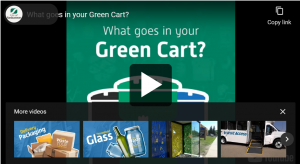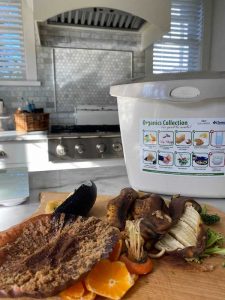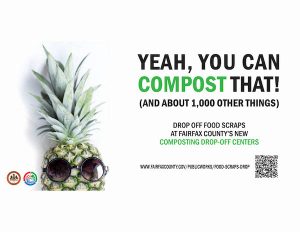In the quest to divert ever more materials from landfills, cut costs, and align municipal efforts with expanded mandates, adding an organics solution to your existing solid waste and recycling program can be a natural next step for many municipalities. While launching a new program can be daunting, we know from experience that as long as the operational puzzle pieces fit together, program coordinators can foster success by adopting the following seven best practices for communicating about a new organics program.
#1: Create a Plan
While the nuts and bolts of municipal organics program delivery vary widely—with collection and disposal (composting) handled by the municipality, third-party vendors, or a combination—the key to reaching program goals remains constant.
Effective, efficient communication with the residents who use the program will enable you to meet your objectives for diversion, compliance and positive environmental impact. It all begins with a practical yet detailed plan for how you’ll introduce residents to the new program, onboard them with timely education, anticipate their questions, and keep them engaged.
Your plan needs to address the three “Ts”:
- Team: Identify the people on your project team and what each person’s role will be. Once you know who’s working with you, you’ll be able to figure out who owns which tasks.
- Tasks: Outline the steps needed to launch your new program. Start by defining the parts of the project, perhaps in order of when they need to happen: Pre-launch communication, new service communication, and follow-up. Then get nitty-gritty. For example, if you want to provide a printed “FAQ” sheet to each resident with container delivery, you’ll need to identify acceptable and unacceptable materials; draft the document and build in time for internal feedback; identify a designer and printer and identify how long those processes will take; and figure out how the completed resource will be kept dry and attached to the container. Having trouble getting started? Try working backward from your target.
- Targets: As you create tasks and due dates, work toward making timelines realistic rather than aspirational. Nothing kills project momentum quite like impossible targets!
Targets also include overall goals. With your team, answer: What does the program need to accomplish in the big picture, and how does communication support our broader operational and organizational goals?
Tip: Build a tactical project plan using an Excel spreadsheet. Create columns for team, task, description, deadlines, resources required, and extra planning notes.
Share program information with local media and grassroots organizations to help reach a broad audience – and be sure your customer service team is prepared to interact with people who hear about the program and reach out with further questions.
- Prepare. Gather important details, such as who can take part, when the program begins, what materials are included, and where residents can learn more.
- Develop. Create a program “FAQ” document for the customer service team and other frontline staff members, then provide training on the document. Always communicate internally first and externally second.
- Distribute. Once the internal team is confident on program specifics, create a press release to share externally with local media: TV, newspapers and radio, as well as digital-only news providers and social accounts in your area. Share with local sustainability organizations, too.
Tip: Build a media kit based on your FAQ document. This will help reporters self-educate about your program and help save you time!
#3: Tap into Events
Host an educational activity about your program to connect directly with residents and build trust, answer questions, and gain a better understanding of any program objections and challenges so that you can address them in future educational materials.
- Identify: Make a list of events and locales where you can provide an educational activity that ties to organics. Think about outdoor festivals, farmers’ markets, city hall or other community buildings, and busy malls or shopping areas. Take a page from the marketing playbook and identify your audiences before developing tools to reach them, suggests the guide to social marketing by the Ohio Department of Natural Resources.
- Promote: Use your website, social media, and community bulletin boards (digital and traditional) to get the word out. Don’t forget to share the details with aligned community organizations (see No. 2).
- Display: Share educational collateral with residents and ask for their questions and input.
- Swag: Provide free items such as stickers, reusable bags and magnets that include your website and important program details (if there’s room).
- Surveys: Measure the effectiveness of in-person events by providing a brief post-event survey that relates to your goals.
Tip: As your program’s “eyes and ears,” the communication team —even if it’s just one person — often occupies a unique position to deliver important feedback and ideas to the operations team to improve customer service and efficiency.

#4: Ply All Platforms
Using many different platforms to educate about your program will help you meet community members where they are and ensure a wide understanding of your program, its benefits, and how to get involved. According to the Carton Council, “strategically using a variety of media to communicate to the public engages more participation.” Bake into your communication plan a series of messages to share across various media: owned (social media, website, blog), earned (community partner sites and social media), and paid (local newspapers, magazines, radio and TV stations).
You can “batch” content around specific messages to maximize your efforts:
- Program start date
- Benefits highlights
- Accepted/non-accepted materials
- Kitchen bin and curbside cart maintenance tips
- How-tos, such as making paper bin liners from newspaper
- Invitations to facility open houses
- Delivery information: What residents get — and when
- Links to resources, such as collection calendars and “what goes in” databases
Tip: Approach local newspapers and radio and television stations about free public service announcements.
#5: Capitalize on Carts & Containers
Providing curbside collection? Take advantage of cart and kitchen bin deliveries by including program information with containers.
- Program Packet: Create a guide to help residents use the organics program. You also can include a refresher on other waste and recycling services.
- Samples: Include approved kitchen container bags and/or coupons
- Signage: Add a decal to kitchen containers to visually depict what goes in and what doesn’t.
Tip: For organics drop-off sites, ample signage about what’s compostable is critical. Check out Fairfax County, Va.’s website for examples of clear graphics.

#6: Make Your Website the Program Hub
When all your materials and promotions direct residents to your website, you teach them it’s the best place to find the answers to questions about your programs. On its website, the City of Brookline, Mass. tells residents about their curbside collection program and includes a searchable materials database. Your website also can supply you with the data you need to tailor your messages to real resident needs.
- Centralize: For simplicity, keep all program details in one place on your site.
- Analyze: Gain insight into your website visitors’ needs through analytics and add visibility to the most commonly searched materials.
- Engage: Encourage residents to sign up for digital reminders so you can quickly educate them about program changes as they arise.
- Connect: Ensure you’re able to connect with all of your residents by offering different language options and providing them with accessibility compliant communications tools. Being accessible is not only the law, it is the right thing to do.
Tip: Digital communication tools and apps that integrate with your website can provide easy-to-access analytics and help you stay in touch with residents with less effort.

#7: Stand Out to Keep Up
Even as we encourage program participation and help residents adopt new behaviors through our communications, it’s important as educators to understand the unprecedented volume of messaging that the average person is exposed to each day. More than ever before, we are charged with cutting through the clutter — as the City of Toronto does with this video— to keep the value of participating in our programs top-of-mind. This begs the question: On a limited budget, what’s the key to maintaining resident engagement for the months and years after program launch?
- Branding: For a municipal organics program, branding looks like expertise and reliability. When you provide accurate, timely information and service that residents can depend on, you’re building trust in what you do and what you say. That’s the heart of a brand, and being trustworthy will make your program stand out like nothing else.
- Content: By its very nature, the content you create about your programs is on its way to “value-added” status: Residents likely can’t get it anywhere else. Exclusive content that’s in the right place at the right time? Now that’s the whole enchilada!
- Analytics: Digital tools and apps can make communication with residents quicker and easier. Digital analytics resulting from resident uptake of these tools also can inform your messaging by providing valuable insights about things like what’s confusing people (search terms) and what’s most helpful to them (page views).
Tip: Streamline your communications about waste, recycling and organics programs through technology and automation.
As municipalities find themselves increasingly squeezed for time due to labor shortages—just as reporting requirements for waste programs, in many areas, become more robust—a new program launch creates a well-timed opportunity for environmental educators to grow their knowledge about digital communication solutions to boost efficiency while serving resident needs better than ever before.
Jenny English is a Waste and Recycling Specialist for ReCollect with over 10 years of experience in the industry. She is recognized as a Next-Generation Leader in the waste and recycling industry and was named to Waste360’s 2017 40 Under 40 Award list. She can be reached by email at – [email protected]
Looking to amplify your waste and recycling programs? ReCollect can help – https://learn.recollect.net/lets-talk/
